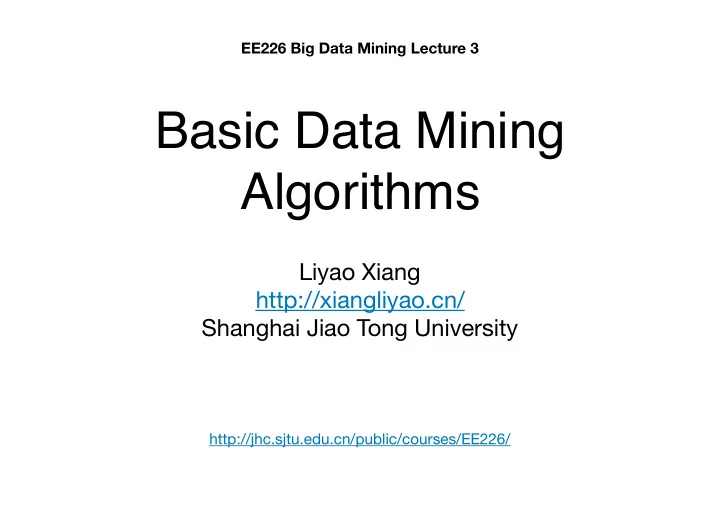

EE226 Big Data Mining Lecture 3 Basic Data Mining Algorithms Liyao Xiang http://xiangliyao.cn/ Shanghai Jiao Tong University http://jhc.sjtu.edu.cn/public/courses/EE226/
Notice • There will be a quiz in the next week’s class. Please take a piece of paper and pens.
Reference and Acknowledgement • Most of the slides are credited to Prof. Jiawei Han’s book “Data Mining: Concepts and Techniques.”
Outline • Basic Concepts in Frequent Pattern Mining • Frequent Itemset Mining Methods • Pattern Evaluation Methods
Outline • Basic Concepts in Frequent Pattern Mining • Frequent Itemset Mining Methods • Pattern Evaluation Methods
Basic Concepts • Frequent pattern: a pattern (a set of items, subsequences, substructures …) that appear frequently in a database • Finding frequent patterns is key to mining associations, correlations, clustering, classification and other relationships among data. • Applications: basket data analysis, cross-marketing, catalog design …
Basic Concepts TID Items Purchased • itemset: a set of one or more items 10 Beer, Nuts, Diaper 20 Beer, Co ff ee, Diaper • k-itemset: X = {x 1 , …, x k } 30 Beer, Diaper, Eggs • (absolute) support, or support 40 Nuts, Eggs, Milk count of X: frequency or 50 Nuts, Co ff ee, Diaper, Eggs, Milk occurrence of an itemset X • (relative) support: the fraction of transactions that contains X over all transaction customers customers who got beer who got diaper • An itemset X is frequent if X’s support is no less than a defined threshold min_sup customers who got both
Basic Concepts TID Items Purchased 10 Beer, Nuts, Diaper • support: probability that a 20 Beer, Co ff ee, Diaper transaction contains X ⋃ Y 30 Beer, Diaper, Eggs support(X ⇒ Y) = P(X ⋃ Y) 40 Nuts, Eggs, Milk • confidence: conditional prob. 50 Nuts, Co ff ee, Diaper, Eggs, Milk that a transaction having X also contains Y confidence(X ⇒ Y) = P(Y|X) customers customers who got beer who got diaper P ( Y | X ) = support( X ∪ Y ) support( X ) customers who got both
Basic Concepts • min_sup: minimum support TID Items Purchased threshold 10 Beer, Nuts, Diaper • min_conf: minimum support 20 Beer, Co ff ee, Diaper confidence threshold 30 Beer, Diaper, Eggs • e.g., find all rules X ⇒ Y with 40 Nuts, Eggs, Milk min_sup and min_conf 50 Nuts, Co ff ee, Diaper, Eggs, Milk let min_sup = 50%, min_conf = 50% frequent pattern: Beer: 3, Nuts: 3, Diaper: 4, Eggs: 3, {Beer, Diaper}: 3 customers customers • Association rules: who got beer who got diaper Beer ⇒ Diaper (60%, 100%) Diaper ⇒ Beer (60%, 75%) customers who got both
Basic Concepts • Association rule mining includes: 1. Find all frequent itemsets: frequency of itemsets ≥ min_sup 2. Generate strong association rules from the frequent itemsets • 1 is the major step, but challenging in that there may be a huge number of itemsets satisfying min_sup • An itemset is frequent ⇒ each of its subsets is frequent • Solution: mine closed frequent itemset and maximal frequent itemset • closed frequent itemset X: X is frequent and there is no super-itemset Y ⊃ X with the same support count as X • closed frequent itemset is a lossless compression of frequent itemset • maximal frequent itemset X: X is frequent and there is no super-itemset Y ⊃ X which is frequent
Basic Concepts • e.g., {<a 1 , …, a 100 >, < a 1 , …, a 50 >}, min_sup = 1 • What is the set of closed frequent itemset? • <a 1 , …, a 100 >: 1, < a 1 , …, a 50 >: 2 • What is the set of maximal frequent itemset? • <a 1 , …, a 100 >: 1 • We can assert <a 2 , a 45 > is frequent since a 2 , a 45 ∈ < a 1 , …, a 50 > but cannot assert their actual support count • How many itemsets are potentially to be generated in the worst case? • When min_sup is low, there exist potentially an exponential number of frequent itemsets • Worst case: M N where M = # distinct items, N = max length of transactions
Summary • frequent pattern • k-itemset • (absolute) support, support count, relative support • min_sup, confidence • closed frequent itemset, maximal frequent itemset
Outline • Basic Concepts in Frequent Pattern Mining • Frequent Itemset Mining Methods • Pattern Evaluation Methods
Frequent Itemset Mining Methods • Apriori: A Candidate Generation-and-Test Approach • Improving the E ffi ciency of Apriori • FP-Growth: A Frequent Pattern-Growth Approach • ECLAT: Frequent Pattern Mining with Vertical Data Format
Apriori • Downward Closure Property: any subset of a frequent itemset must be frequent • e.g., if {beer, diaper, nuts} is frequent, so is {beer, diaper} since every transaction having {beer, diaper, nuts} also contains {beer, diaper} • Apriori employs a level-wise search where k-itemsets are used to explore (k + 1)-itemsets. Steps: 1. Scan database once to get frequent 1-itemsets L 1 2. Join the k-frequent itemsets L k to generate length (k+1) candidate itemsets C’ k+1 3. Prune C' k+1 against the database to get C k+1 4. Scan (Test) database for the count of each candidate in C k+1 , obtain L k+1 5. Terminate when no frequent or candidate set can be generated
Recommend
More recommend